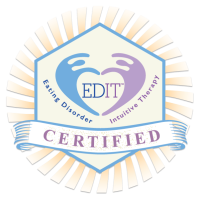Eating Disorders and Art Therapy: Separating from ED
I’d like to introduce you to Ashley Eyre, who was a Counselor Intern under my supervision at Positive Pathways from August, 2015 through July, 2016. She is now who is a Licensed Professional Counselor Candidate and an EDIT™ Certified III – Eating Disorder Treatment Clinician, who continued under my supervision at my previous office location in Denver. Ashley currently meets with clients in Boulder, Colorado. You can contact her with any comments or questions, including how to get started with individual sessions (see bottom of article).
– Dr. Dorie
When considering eating disorders and art therapy, how can clients enhance their recovery through the separation from “ED” (what they might call their eating disorder)? Common with clients suffering from disordered eating, is the assumption that the internal dilemma is truly about calories, weight and food (Johnston, 1996). In introducing art to the therapeutic process, we can begin to access that which hides behind the disordered eating pattern (Brooke, 2008). Though there are several effective eating disorder and art therapy interventions that can help access our deeper selves, the “Create an Image of the Eating Disorder” intervention is extremely powerful.
Using clay or paper and oil pastels (or any other drawing material), the therapist invites the client to create and image of the eating disorder. They will then invite the client to give this disorder a name, a face, does he/she have a body? How big is this character? This eating disorder and art therapy intervention assists clients in recognizing that they have both an authentic self and a voice of their disordered eating pattern. By externalizing and characterizing the eating disorder, the client can begin to separate their true self from this false self; the disordered eating that developed as a coping strategy. Further, the client can begin to dialogue with the eating disorder, give it a name and express their true feelings about the influence that this character has had on their lives. Additionally, the individual can also thank the character of the eating disorder for the coping methods that were provided during the clients time of need. As the separation process begins, a lot of thoughts, feelings and emotions will surface. While assisting the client in processing through the loss of this false self, the client is also led and assisted in developing new and more effective coping strategies.
Through this process alone, a lot of information can be uncovered. Some clients experience anger as they begin to realize that this voice is NOT their own and that they do not want to listen to it anymore. Some actually realize that their eating disorder is likened to a friend that lives with them on a daily basis and that separating will involve a significant grieving process. Further, as we begin to dialogue with the eating pattern and investigate its nature, we can continue to distinguish and delineate the thoughts and patterns involved. When the therapist and client can look at a thought together, they can examine it carefully and ask whether it is our client’s true self speaking or whether it is the voice of ED, the eating disorder. ED will become trickier and trickier as he doesn’t want to be ignored.
Powerful recovery opportunities can unfold with eating disorders and art therapy exploration. As our clients realize the areas of their lives that ED is ruling, they have to be creative and counter his dominance with their true self. As they listen and act more consistently with the guidance of their authentic desires, needs and goals, they can begin to rely less and less on ED and start heading towards their full potential.
References:
Brook, S. (2008). The Creative Therapies and Eating Disorders. Springfield, IL: Charles Thomas
Johnston, A. (1996). Eating in the Light of the Moon. Oceanside, CA: Gurze Books
*****
Want to experience ART THERAPY? Contact Ashley Eyre, MA, LPCC – the author of this blog article. Share is an EDIT™ Certified III – Eating Disorder Treatment Clinician, and conducts Art Therapy at her office in Boulder, Colorado. EMAIL ASHLEY
Interested in a FREE consultation with Dr. Dorie? Dr. Dorie is passionate about her method of Eating Disorder Intuitive Therapy (EDIT)™ to help people overcome eating disorders and addictions. She provides customized counseling for eating disorders and alcohol / drug addiction at her Positive Pathways treatment center in Evergreen, Colorado – and EDIT™ eating disorder training and certification for coaches and clinicians worldwide. CALL 303-494-1975 – EMAIL DR. DORIE – GET CERTIFIED

